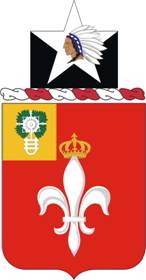1st Battalion
The 1st Battalion, 12th Field Artillery was constituted on 3 June 1916 as an element of the 2nd Division. The 12th Regiment arrived in France and fought bravely in four offenses in World War I. Following the armistice, the 12th joined the U.S. Army of Occupation, stationed in the Colenz area, then later returned to Fort Sam Houston, Texas, and inactivated. On 1 May 1939, the regiment was reactivated as a 155mm howitzer battalion. The 12th joined the armies staging in England for the invasion of France. On D-Day plus three, the 12th landed on Omaha Beach in Normandy and participated in the breakout from the beachhead. Later, the 12th was in the thick of the fighting of the Battle of the Bulge and it joined in the race across Germany and on VE Day was in Pilson, Czechoslovakia. The 12th returned to Fort Lewis, Washington where it remained until it was inactivated.
When the Korean War broke out, the 12th was reactivated and in July 1950, departed for Korea where it participated in the fighting on the Pusan Perimeter. Later it face the Red Chinese at the Chong-chon river. The unit became Battery A, 12th field Artillery Battalion, an element of the 2nd Infantry Division. A year later, the battalion endured some of the bloodiest fighting of the Korean War at T-bone Mountain, the Battle of Old Baldy, White Horse Mountain, and the Battle of Pork Chop Hill. In 1954, following the Korean Armistice Agreement, the battalion returned to Fort Lewis, Washington and then moved to Fort Benning, Georgia.
In 1965, with its Honest John Rockets and 8 inch howitzers, the 1-12th returned to Korea. On 20 February 1971, the unit inactivated at Fort Lewis, Washington, and immediately reactivated at Fort Sill, Oklahoma on 1 April 1971. The 1st Battalion, 12th Field Artillery became the world's first Lance Missile Battalion with a wartime mission to provide nuclear and non-nuclear fires.
The 1-12th began converting to the Multiple Launch Rocket System in August 1992.
During the year 2000, the Raider 1-12 FA (MLRS) conducted many battalion and battery-level FTXs and EXEVALs at Fort Sill.
1-12 FA also deployed its 0&1 to Fort Stewart, Georgia, and the NTC for a successful rotation with the 3d BCT, 3d IN Division, in April. [3]
Campaigns
World War I
Aisne, Aisne-Marne, St. Mihiel, Meuse-Argonne, Lorraine 1918, Ile de France 1918
World War II
Normandy, Northern France, Rhineland, Ardennes-Alsace, Central Europe
Korean War
UN Defensive, UN Offensive, CCF Intervention, First UN Counteroffensive, CCF Spring Offensive, UN Summer-Fall Offensive, Second Korean Winter, Korea: Summer-Fall 1952, Third Korean Winter, Korea: Summer 1953
Iraq War
Transition of Iraq, National Resolution March 2003 - April 2005 part of initial attack on bagdad, attached to 3rd infantry division, 3 days of Mlrs steel rain....March, 2003- 2006 Operation Iraqi Freedom
2nd Battalion
First constituted 1 July 1916 in the Regular Army as Battery B, 12th Field Artillery. It was later organized 7 June 1917 at Fort Myer, Virginia, as an element of the 2nd Division (later redesignated as the 2nd Infantry Division). From here the unit was reorganized and redesignated 1 October 1940 as Battery B, 12th Field Artillery Battalion (B-12th FAB). On 15 October 1948 the unit was inactivated at Fort Lewis, Washington. On 10 November 1951 Battery B consolidated with Battery B, 503rd Field Artillery Battalion (B-503rd FAB) (active), and consolidated unit designated as Battery B, 12th Field Artillery Battalion (B-12th FAB). The unit inactivated on 20 June 1957 at Fort Lewis, Washington, and relieved from assignment to the 2nd Infantry Division; concurrently, redesignated as Headquarters and Headquarters Battery, 2nd Battalion, 12th Artillery (HHB, 2-12th Artillery). Later it redesignated on 1 May 1960 as Headquarters and Headquarters Battery, 2nd Howitzer Battalion, 12th Artillery, assigned to the 8th Infantry Division, and activated in Germany (organic elements concurrently constituted and activated). The battalion inactivated 1 April 1963 in Germany and relieved from assignment to the 8th Infantry Division. 13 September 1969 the battalion redesignated as the 2nd Battalion, 12th Artillery, and activated in Vietnam. The battalion inactivated 29 August 1971 at Fort Lewis, Washington. Three days later (1 September 1971 ) it redesignated as the 2nd Battalion, 12th Field Artillery. Activated once again on 1 April 1976 at Fort Sill, Oklahoma. The unit inactivated on 15 September 1984 at Fort Sill, Oklahoma. The unit moved overseas and activated on 16 July 1987 in Herzogenaurach, Germany as a LANCE missile Battalion but was later inactivated on 15 April 1992. The battalion once again redesignated on 1 October 2005 as the 2nd Battalion, 12th Field Artillery Regiment. The battalion was assigned on 1 June 2006 to the newly formed 4th Brigade Combat Team, 2nd Infantry Division, and activated at Fort Lewis, Washington. [4]
Campaigns
World War I
Aisne, Aisne-Marne, St. Mihiel, Meuse-Argonne, Lorraine 1918, Ile de France 1918
World War II
Normandy, Northern France, Rhineland, Ardennes-Alsace, Central Europe
Korean War
UN Defensive, UN Offensive, CCF Intervention, First UN Counteroffensive, CCF Spring Offensive, UN Summer-Fall Offensive, Second Korean Winter, Korea: Summer-Fall 1952, Third Korean Winter, Korea: Summer 1953
Vietnam
Summer-Fall 1969, Winter-Spring 1970, Sanctuary Counteroffensive, Counteroffensive: Phase VII, Consolidation I
Iraq
Iraqi Surge, Iraqi Sovereignty, New Dawn
This page is based on this
Wikipedia article Text is available under the
CC BY-SA 4.0 license; additional terms may apply.
Images, videos and audio are available under their respective licenses.






